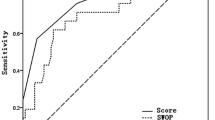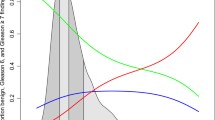Abstract
Purpose
The aim of this study was to investigate the cumulative probability of prostate cancer detection according to free/total prostate-specific antigen (PSA) ratio in men with PSA levels of 2.1–10.0 ng/ml and also likelihood of detecting clinically insignificant prostate cancer in population-based screening.
Methods
A total of 1,277 men aged between 55 and 69 years with total PSA (tPSA) levels of 2.1–10.0 ng/ml screened in population screening in Kanazawa city and underwent systematic transrectal ultrasonography-guided prostate biopsy between 2000 and 2011 were enrolled. The cumulative probability of prostate cancer detection in biopsy according to age, serum tPSA, and free-to-total PSA (f/t PSA) ratio was investigated. The clinicopathological features of screening-detected prostate cancer were also investigated.
Results
Of the 1,277 subjects in the study population, 320 (25.0 %) were diagnosed with prostate cancer during the observation period. The probabilities of prostate cancer detection at 3 years were 64.5, 41.2, 28.5, and 14.3 % for the men with f/t PSA ratio ≤0.08, 0.09–0.13, 0.14–0.22, and ≥0.23, respectively; the differences in probabilities of prostate cancer detection among men with different f/t PSA ratios were statistically significant. Among 320 patients, 84 (26.3 %) had favorable clinicopathological features that made them suitable for active surveillance. The f/t PSA ratio in unfavorable cancer patients was significantly lower that that in favorable cancer patients.
Conclusion
The present study demonstrated that the f/t PSA ratio was a strong predictor of future cancer detection and unfavorable cancerous features in prostate biopsy in men with total PSA levels of 2.1–10.0 ng/ml at population screening.

Similar content being viewed by others
References
Andriole GL, Levin DL, Crawford ED et al (2005) Prostate cancer screening in the prostate, lung, colorectal and ovarian (PLCO) cancer screening trial: findings from the initial screening round of a randomized trial. J Natl Cancer Inst 97:433–438
Argangeli CG, Humphrey PA, Smith DS et al (1998) Percentage of free serum prostate-specific antigen as a predictor of pathologic features of prostate cancer in a screening population. Urology 51:558–565
Aus G, Becker C, Franzén S, Linja H, Lodding P, Hugosson J (2004) Cumulative prostate cancer risk assessment with the aid of the free-to-total prostate specific antigen ratio. Eur Urol 45:160–165
Bouchardy C, Fioretta G, Rapiti E et al (2008) Recent trends in prostate cancer mortality show a continuous decrease in several countries. Int J Cancer 123:421–429
Cancer International Union Against (1997) Urologic tumors: prostate. In: Sobin LH, Wittekind CH (eds) TNM classification of malignant tumours, 5th edn. John Wiley and Sons, New York, pp 170–173
Carter HB, Albertsen PC, Barry MJ et al (2013) Early detection of prostate cancer: AUA guideline. J Urol 190:419–426
Catalona WJ, Smith DS, Ratliff TL et al (1991) Measurement of prostate-specific antigen in serum as a screening test for prostate cancer. New Engl J Med 324:1156–1161
Crawford ED, Moul JW, Rove KO et al (2011) Prostate-specific antigen 1.5–4.0 ng/ml: a diagnostic challenge and danger zone. BJU Int 108:1743–1749
Finne P, Auvinen A, Määttänen L et al (2008) Diagnostic value of free prostate-specific antigen among men with a prostate-specific antigen level of <3.0 μg/l. Eur Urol 54:362–370
Ishidoya S, Ito A, Orikasa K et al (2008) The outcome of prostate cancer screening in a normal Japanese population with PSA of 2–4 ng/ml and the free/total PSA under 12%. Jap J Clin Oncol 38:844–848
Ito K, Yamamoto T, Ohi M et al (2003) Free/total PSA ratio is a powerful predictor of future prostate cancer morbidity in men with initial PSA levels of 4.1–10.0 ng/ml. Urology 61:760–764
Kakehi Y, Kamoto T, Shiraishi T et al (2008) Prospective evaluation of selection criteria for active surveillance in Japanese patients with stage T1cN0M0 prostate cancer. Jpn J Clin Oncol 38:122–128
Kitagawa Y, Mizokami A, Nakashima K et al (2011) Clinical outcomes of prostate cancer patients detected by prostate-specific antigen-based population screening in Kanazawa city. Jpn Int J Urol 18:592–596
Klotz L, Zhang L, Lam A, Nam R, Mamedov A, Loblaw A (2010) Clinical results of long-term follow-up of a large, active surveillance cohort with localized prostate cancer. J Clin Oncol 28:126–131
Kobori Y, Kitagawa Y, Mizokami A, Komatsu K, Namiki M (2008) Free-to-total prostate-specific antigen (PSA) ratio contributes to an increased rate of prostate cancer detection in a Japanese population screened using a PSA level of 2.1–10.0 ng/ml as a criterion. Int J Clin Oncol 13:229–232
Orsted DD, Nordestgaard BG, Jensen GB, Schnohr P, Bojesen SE (2012) Prostate-specific antigen and long-term prediction of prostate cancer incidence and mortality in the general population. Eur Urol 61:865–874
Pannek J, Rittenhouse HG, Chan DW et al (1998) The use of percent free prostate specific antigen for staging clinically localized prostate cancer. J Urol 159:1238–1242
Pelzer AE, Volgger H, Bektic J et al (2005) The effect of percentage free prostate-specific antigen (PSA) level on the prostate cancer detection rate in a screening population with low PSA levels. BJU Int 96:995–998
Roddam AW, Duffy MJ, Hamdy FC et al (2005) Use of prostate-specific antigen (PSA) isoforms for the detection of prostate cancer in men with a PSA level of 2–10 ng/ml: systematic review and meta-analysis. Eur Urol 48:386–399
Schröder FH (2001) Diagnosis, characterization and potential clinical relevance of prostate cancer detected at low PSA ranges. Eur Urol 39:49–53
Thompson IM, Pauler DK, Goodman PJ et al (2004) Prevalence of prostate cancer among men with a prostate-specific antigen levels ≤4.0 ng/ml. N Engl J Med 350:2239–2246
Acknowledgments
We thank Dr. Mitsuharu Sasaki of Tohoku University, Sendai, Japan, for valuable advice. We also thank Dr. Yasuo Takeda and Dr. Atsushi Hashiba of Kanazawa Medical Association for providing data of the Kanazawa population-based screening cohort.
Conflict of interest
None declared.
Author information
Authors and Affiliations
Corresponding author
Rights and permissions
About this article
Cite this article
Kitagawa, Y., Ueno, S., Izumi, K. et al. Cumulative probability of prostate cancer detection in biopsy according to free/total PSA ratio in men with total PSA levels of 2.1–10.0 ng/ml at population screening. J Cancer Res Clin Oncol 140, 53–59 (2014). https://doi.org/10.1007/s00432-013-1543-9
Received:
Accepted:
Published:
Issue Date:
DOI: https://doi.org/10.1007/s00432-013-1543-9




